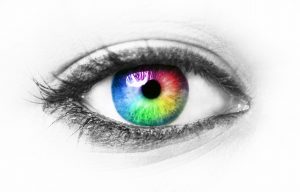There is a lot of buzz and talk lately about light therapy and the effects that it can have one a person. It is also a frequent topic of questioning that I get when people walk by our therapy rooms and look in inquisitively. They see our syntonic lights and question how it could help them or their children. Other times I have someone come in for a consult or visit to the clinic and just come out and ask, “What is this light therapy program I keep hearing about?”
The use of light has typically been used by developmental optometrists to help treat those with issues related to visual function.

However, we are now seeing it being used for symptoms such as jet lag, headaches, sleep disorders, and overall dysregulation conditions. And it is this relatively short-term therapy that has helped improve visual skills, peripheral vision, memory, behavior, mood swings, emotional regulation, general attitude and performance, overall academic achievement, and daily functioning.
Here at our clinic, we have seen large numbers of children, teens, and adults with learning problems and issues in their visual processing systems. Most participants come in struggling with how their brain is processing and interpreting the information they are seeing. They may have been to optometrists before and were told that they have excellent vision, or maybe they did need glasses, but the issues they were having persisted. Typically the sensitivity and symptoms they are struggling with show improvements after a few sessions are completed.
Others who have participated in light therapy or syntonics have reported a wide range of benefits that surpasses the symptoms they were looking to address, depending on their initial issues and experiences.

Some parents have noticed that for their schooled aged children, they begin to get better grades; homework no longer needs so much effort to complete, especially reading. Our adults have reported that they work more efficiently in the office or excel at projects and tasks that usually have been a roadblock in their day. We have also heard that non-readers pick up books and read for fun for the first time, our athletes have improved at sports, and headaches and motion sickness has gone away.
And then we hear about some improvements occurring in areas that you might not associate with vision or the eyes. Those individuals who are reserved and shy or anxious seem to become more outgoing and have more self-esteem overall. They start to show confidence in trying new things and going to new places without transition issues and meltdowns. Even those that struggled with social cues and appropriateness with their peers tend to start socializing appropriately and pick up faster on other signals. And these results can be a life-changing experience for everyone in the family!
I know. While this concept and use of light therapy to help various issues and symptoms may sound like the promises of a “miracle,” syntonic phototherapy – or light therapy – has been used clinically for more than 70 years. Some of the nerves that are located in the eyes connect to the retina and then directly to areas in the brain such as the hypothalamus and pineal gland. These centers in the brain influence electrical, chemical, and hormonal balances, affecting all body functions, including vision. It has been proven that when specific light wavelength frequencies (colors) are administered by way of the eyes, beneficial results occur in the body that have been found to directly affect behavior, mood, and physiological functions.

So what do we do?
You see, we offer several means of how the therapy is administered, and it is not something that many come across from often. What is done during a session is that the person is asked to look at a light instrument called a syntonizer where there are colored filters at the other end. The individual sees a glowing dot of the saturated color or colors, which can either be steady or slowly fluctuating on and off light. Many children and adults have commented that it is quite odd when you first see or experience it. Of course, we do pre and post-testing before the therapy and after to see any changes that may have taken place in the visual field, but it is genuinely the functional changes we love to hear about and see!
Along with syntonics, there is another light therapy we offer called Red/Infrared Light therapy that has a variety of benefits and can be part of an overall wellness routine. Red light therapy can aid in faster healing, boost one’s immune system, help in anti-aging, mood enhancement, muscle recovery, and more. Some that have come in for these sessions report that it has helped reduce inflammation and pain, fine lines and wrinkles, treat their acne, and even enhance their muscle recovery and wound healing. Red/Infrared Light therapy has many benefits, and I go more in-depth on these in the upcoming blog, Invoking the Influence & Potential of Red/Infrared Light Therapy.
It is a goal at our clinic to help and offer an array of therapy approaches to address physical, mental, emotional, and behavioral symptoms and issues. Light therapy, regardless of which kind, is known as a bottom-up approach that implements the treatment with little to no cognitive effort. It is considered an input therapy and requires no interaction, response, or reaction from the person receiving it. It then is one that children of young ages (3 years) to those teens and older adults looking to improve their processing or suffering from physical or mental issues can do easily.
As specialists trained in working with neurological processing issues, the Sensory Stepping Stones clinic and staff can help to assess and combat the behaviors and habits that you or your child is experiencing, especially when it comes to their visual processing systems. We are here to help you overcome and work through the issues and symptoms that you may be seeing so that you and your child can experience a different kind of life!
Sign up for your Free Consultation today!
Join our Facebook Group, and like/follow our Facebook Page or Instagram for more articles and tips!
Melissa Bianchini is a licensed clinical social worker in New York and the owner and executive director at Sensory Stepping Stones, LLC. Her career has spanned over 20 years working with children and families around neurological processing concerns, stress-related trauma, and anxiety. Her passion in life is to make a difference in the lives of kids and families that she works with. It has led her spirit to create a facility that facilitates a holistic approach to overall health, wellness, and processing development for those 3 through 93 years young! To unwind and reconnect, Melissa enjoys spending time at home with her husband, Damian, and her dogs and cats, exercising, eating chocolate (of course!), and doing anything that involves nature!

